Identification of Potent Natural Resource Small Molecule Inhibitor to Control Vibrio cholera by Targeting Its Outer Membrane Protein U: An In Silico Approach
Abstract
:1. Introduction
2. Material and Methods
2.1. Protein Preparation and Binding Site Identification
2.2. Compound Library Preparation, Virtual Screening, and Molecular Docking
2.3. Physiochemical Properties and ADMET Prediction
2.4. Molecular Dynamic (MD) Simulation
3. Results and Discussion
4. Conclusions
Author Contributions
Funding
Institutional Review Board Statement
Informed Consent Statement
Data Availability Statement
Conflicts of Interest
Sample Availability
References
- Ali, M.; Nelson, A.R.; Lopez, A.L.; Sack, D.A. Updated global burden of cholera in endemic countries. PLoS Negl. Trop. Dis. 2015, 9, e0003832. [Google Scholar] [CrossRef] [PubMed] [Green Version]
- Ebob, T.J. Epidemiological distribution of different vibrio cholerae strains causing cholera disease in endemic countries: A review. J. Adv. Med. Res. 2019, 31, 1–15. [Google Scholar] [CrossRef] [Green Version]
- Silva, A.J.; Benitez, J.A. Vibrio cholerae biofilms and Cholera Pathogenesis. PLoS Negl. Trop. Dis. 2016, 10, e0004330. [Google Scholar] [CrossRef] [PubMed] [Green Version]
- Song, T.; Mika, F.; Lindmark, B.; Liu, Z.; Schild, S.; Bishop, A.; Zhu, J.; Camilli, A.; Johansson, J.; Vogel, J.; et al. A new Vibrio cholerae sRNA modulates colonization and affects release of outer membrane vesicles. Mol. Microbiol. 2008, 70, 100–111. [Google Scholar] [CrossRef] [Green Version]
- Provenzano, D.; Klose, K.E. Altered expression of the ToxR-regulated porins OmpU and OmpT diminishes Vibrio cholerae bile resistance, virulence factor expression, and intestinal colonization. Proc. Natl. Acad. Sci. USA 2000, 97, 10220–10224. [Google Scholar] [CrossRef] [Green Version]
- Crawford, J.A.; Kaper, J.B.; DiRita, V.J. Analysis of ToxR-dependent transcription activation of ompU, the gene encoding a major envelope protein in Vibrio cholerae. Mol. Microbiol. 1998, 29, 235–246. [Google Scholar] [CrossRef] [Green Version]
- Provenzano, D.; Schuhmacher, D.A.; Barker, J.L.; Klose, K.E. The virulence regulatory protein ToxR mediates enhanced bile resistance in Vibrio cholerae and other pathogenic Vibrio species. Infect. Immun. 2000, 68, 1491–1497. [Google Scholar] [CrossRef] [Green Version]
- Chakrabarti, S.R.; Chaudhuri, K.; Sen, K.; Das, J. Porins of Vibrio cholerae: Purification and characterization of OmpU. J. Bacteriol. 1996, 178, 524–530. [Google Scholar] [CrossRef] [Green Version]
- Mathur, J.; Waldor, M.K. The Vibrio cholerae ToxR-regulated porin OmpU confers resistance to antimicrobial peptides. Infect. Immun. 2004, 72, 3577–3583. [Google Scholar] [CrossRef] [Green Version]
- Shen, J.; Xu, X.; Cheng, F.; Liu, H.; Luo, X.; Shen, J.; Chen, K.; Zhao, W.; Shen, X.; Jiang, H. Virtual screening on natural products for discovering active compounds and target information. Curr. Med. Chem. 2003, 10, 2327–2342. [Google Scholar] [CrossRef]
- Macalino, S.J.; Gosu, V.; Hong, S.; Choi, S. Role of computer-aided drug design in modern drug discovery. Arch. Pharm. Res. 2015, 38, 1686–1701. [Google Scholar] [CrossRef]
- Santana, K.; do Nascimento, L.D.; Lima, E.L.A.; Damasceno, V.; Nahum, C.; Braga, R.C.; Lameira, J. Applications of virtual screening in bioprospecting: Facts, shifts, and perspectives to explore the chemo-structural diversity of natural products. Front. Chem. 2021, 9, 662688. [Google Scholar] [CrossRef]
- Li, H.; Zhang, W.; Dong, C. Crystal structure of the outer membrane protein OmpU from Vibrio cholerae at 2.2 A resolution. Acta Cryst. D Struct. Biol. 2018, 74, 21–29. [Google Scholar] [CrossRef] [Green Version]
- Pettersen, E.F.; Goddard, T.D.; Huang, C.C.; Couch, G.S.; Greenblatt, D.M.; Meng, E.C.; Ferrin, T.E. UCSF Chimera—A visualization system for exploratory research and analysis. J. Comput. Chem. 2004, 25, 1605–1612. [Google Scholar] [CrossRef] [Green Version]
- Tian, W.; Chen, C.; Lei, X.; Zhao, J.; Liang, J. CASTp 3.0: Computed atlas of surface topography of proteins. Nucleic Acids Res. 2018, 46, W363–W367. [Google Scholar] [CrossRef] [Green Version]
- Yang, J.; Roy, A.; Zhang, Y. Protein-ligand binding site recognition using complementary binding-specific substructure comparison and sequence profile alignment. Bioinformatics 2013, 29, 2588–2595. [Google Scholar] [CrossRef]
- Ru, J.; Li, P.; Wang, J.; Zhou, W.; Li, B.; Huang, C.; Li, P.; Guo, Z.; Tao, W.; Yang, Y.; et al. TCMSP: A database of systems pharmacology for drug discovery from herbal medicines. J. Cheminform. 2014, 6, 13. [Google Scholar] [CrossRef] [Green Version]
- Trott, O.; Olson, A.J. AutoDock Vina: Improving the speed and accuracy of docking with a new scoring function, efficient optimization, and multithreading. J. Comput. Chem. 2010, 31, 455–461. [Google Scholar] [CrossRef] [Green Version]
- Huey, R.; Morris, G.M.; Forli, S. Using AutoDock 4 and AutoDock vina with AutoDockTools: A tutorial. Scripps Res. Inst. Mol. Graph. Lab. 2012, 10550, 92037. [Google Scholar]
- Sander, T.; Freyss, J.; von Korff, M.; Rufener, C. DataWarrior: An open-source program for chemistry aware data visualization and analysis. J. Chem. Inf. Model. 2015, 55, 460–473. [Google Scholar] [CrossRef]
- Daina, A.; Michielin, O.; Zoete, V. SwissADME: A free web tool to evaluate pharmacokinetics, drug-likeness and medicinal chemistry friendliness of small molecules. Sci. Rep. 2017, 7, 42717. [Google Scholar] [CrossRef] [Green Version]
- Van Der Spoel, D.; Lindahl, E.; Hess, B.; Groenhof, G.; Mark, A.E.; Berendsen, H.J. GROMACS: Fast, flexible, and free. J. Comput. Chem. 2005, 26, 1701–1718. [Google Scholar] [CrossRef]
- Pol-Fachin, L.; Fernandes, C.L.; Verli, H. GROMOS96 43a1 performance on the characterization of glycoprotein conformational ensembles through molecular dynamics simulations. Carbohydr. Res. 2009, 344, 491–500. [Google Scholar] [CrossRef]
- Schuttelkopf, A.W.; van Aalten, D.M. PRODRG: A tool for high-throughput crystallography of protein-ligand complexes. Acta Cryst. D Biol. Cryst. 2004, 60, 1355–1363. [Google Scholar] [CrossRef] [Green Version]
- Humphrey, W.; Dalke, A.; Schulten, K. VMD: Visual molecular dynamics. J. Mol. Graph. 1996, 14, 33–38. [Google Scholar] [CrossRef]
- Wibbenmeyer, J.A.; Provenzano, D.; Landry, C.F.; Klose, K.E.; Delcour, A.H. Vibrio cholerae OmpU and OmpT porins are differentially affected by bile. Infect. Immun. 2002, 70, 121–126. [Google Scholar] [CrossRef] [Green Version]
- Lionta, E.; Spyrou, G.; Vassilatis, D.K.; Cournia, Z. Structure-based virtual screening for drug discovery: Principles, applications and recent advances. Curr. Top. Med. Chem. 2014, 14, 1923–1938. [Google Scholar] [CrossRef]
- Amarnath Jonniya, N.; Sk, M.F.; Kar, P. Elucidating specificity of an allosteric inhibitor WNK476 among With-No-Lysine kinase isoforms using molecular dynamic simulations. Chem. Biol. Drug Des. 2021, 98, 405–420. [Google Scholar] [CrossRef]
- El-Naggar, M.; Mohamed, M.E.; Mosallam, A.M.; Salem, W.; Rashdan, H.R.; Abdelmonsef, A.H. Synthesis, characterization, antibacterial activity, and computer-aided design of novel quinazolin-2,4-dione derivatives as potential inhibitors against Vibrio cholerae. Evol. Bioinform. 2020, 16, 31933518. [Google Scholar] [CrossRef] [Green Version]
- Newman, D.J.; Cragg, G.M. Natural products as sources of new drugs over the 30 years from 1981 to 2010. J. Nat. Prod. 2012, 75, 311–335. [Google Scholar] [CrossRef] [Green Version]
- Ji, H.F.; Li, X.J.; Zhang, H.Y. Natural products and drug discovery. Can thousands of years of ancient medical knowledge lead us to new and powerful drug combinations in the fight against cancer and dementia? EMBO Rep. 2009, 10, 194–200. [Google Scholar] [CrossRef] [PubMed] [Green Version]
- Kingston, D.G. Modern natural products drug discovery and its relevance to biodiversity conservation. J. Nat. Prod. 2011, 74, 496–511. [Google Scholar] [CrossRef] [PubMed] [Green Version]
- Lagunin, A.; Filimonov, D.; Poroikov, V. Multi-targeted natural products evaluation based on biological activity prediction with PASS. Curr. Pharm. Des. 2010, 16, 1703–1717. [Google Scholar] [CrossRef] [PubMed] [Green Version]
- Clardy, J.; Walsh, C. Lessons from natural molecules. Nature 2004, 432, 829–837. [Google Scholar] [CrossRef]
- Meng, X.Y.; Zhang, H.X.; Mezei, M.; Cui, M. Molecular docking: A powerful approach for structure-based drug discovery. Curr. Comput. Aided Drug Des. 2011, 7, 146–157. [Google Scholar] [CrossRef]
- Gramany, V.; Khan, F.I.; Govender, A.; Bisetty, K.; Singh, S.; Permaul, K. Cloning, expression, and molecular dynamics simulations of a xylosidase obtained from Thermomyces lanuginosus. J. Biomol. Struct. Dyn. 2016, 34, 1681–1692. [Google Scholar] [CrossRef]
- Kuzmanic, A.; Zagrovic, B. Determination of ensemble-average pairwise root mean-square deviation from experimental B-factors. Biophys. J. 2010, 98, 861–871. [Google Scholar] [CrossRef] [Green Version]
- Mazola, Y.; Guirola, O.; Palomares, S.; Chinea, G.; Menendez, C.; Hernandez, L.; Musacchio, A. A comparative molecular dynamics study of thermophilic and mesophilic beta-fructosidase enzymes. J. Mol. Model. 2015, 21, 2772. [Google Scholar] [CrossRef]
- Hubbard, R.E.; Kamran Haider, M. Hydrogen bonds in proteins: Role and strength. In eLS; John Wiley and Sons: Hoboken, NJ, USA, 2001. [Google Scholar]
- Maisuradze, G.G.; Liwo, A.; Scheraga, H.A. Principal component analysis for protein folding dynamics. J. Mol. Biol. 2009, 385, 312–329. [Google Scholar] [CrossRef] [Green Version]
- David, C.C.; Jacobs, D.J. Principal component analysis: A method for determining the essential dynamics of proteins. Methods Mol. Biol. 2014, 1084, 193–226. [Google Scholar] [CrossRef] [Green Version]
- Tiana, G.; Simona, F.; De Mori, G.M.; Broglia, R.A.; Colombo, G. Understanding the determinants of stability and folding of small globular proteins from their energetics. Protein Sci. Publ. Protein Soc. 2004, 13, 113–124. [Google Scholar] [CrossRef]
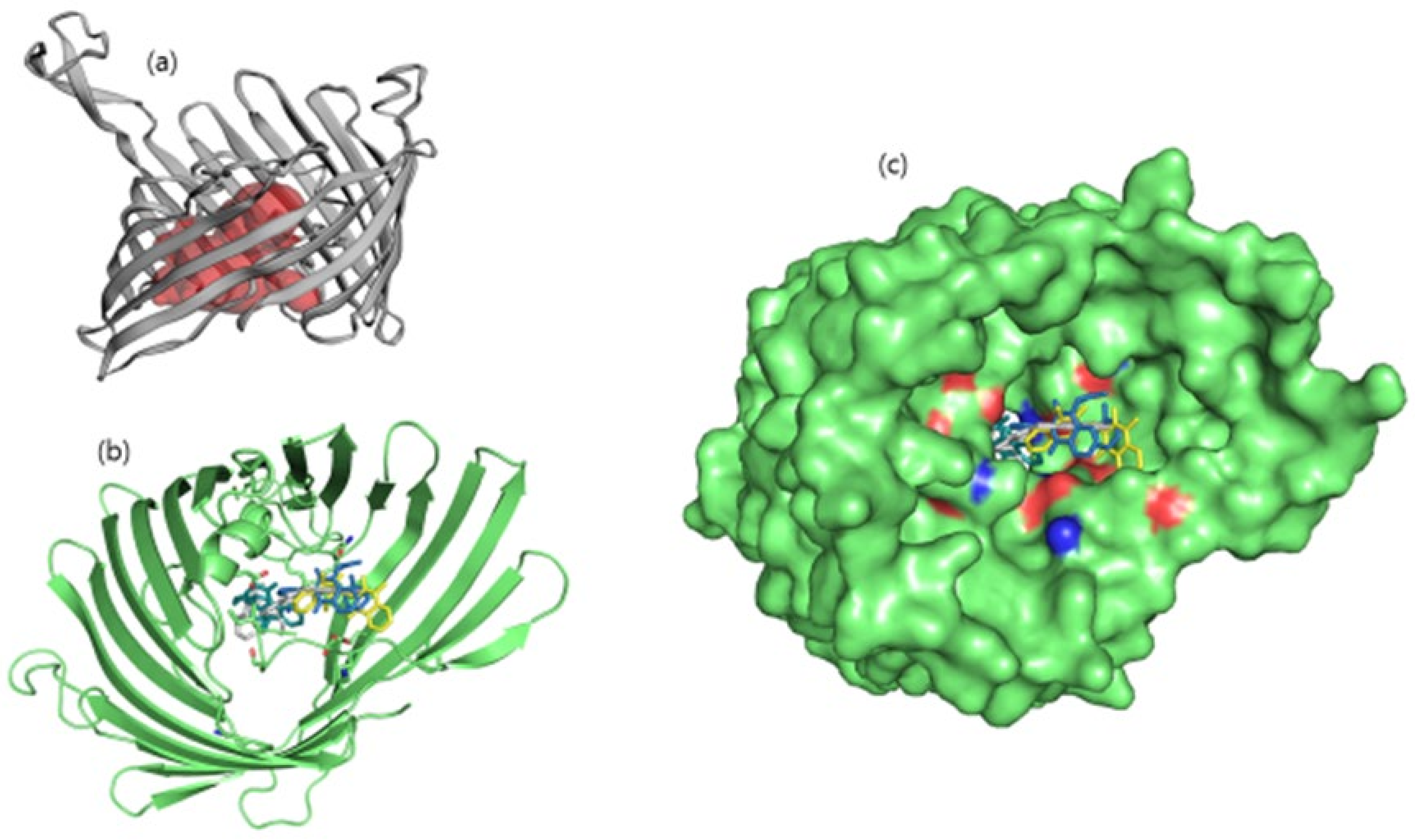


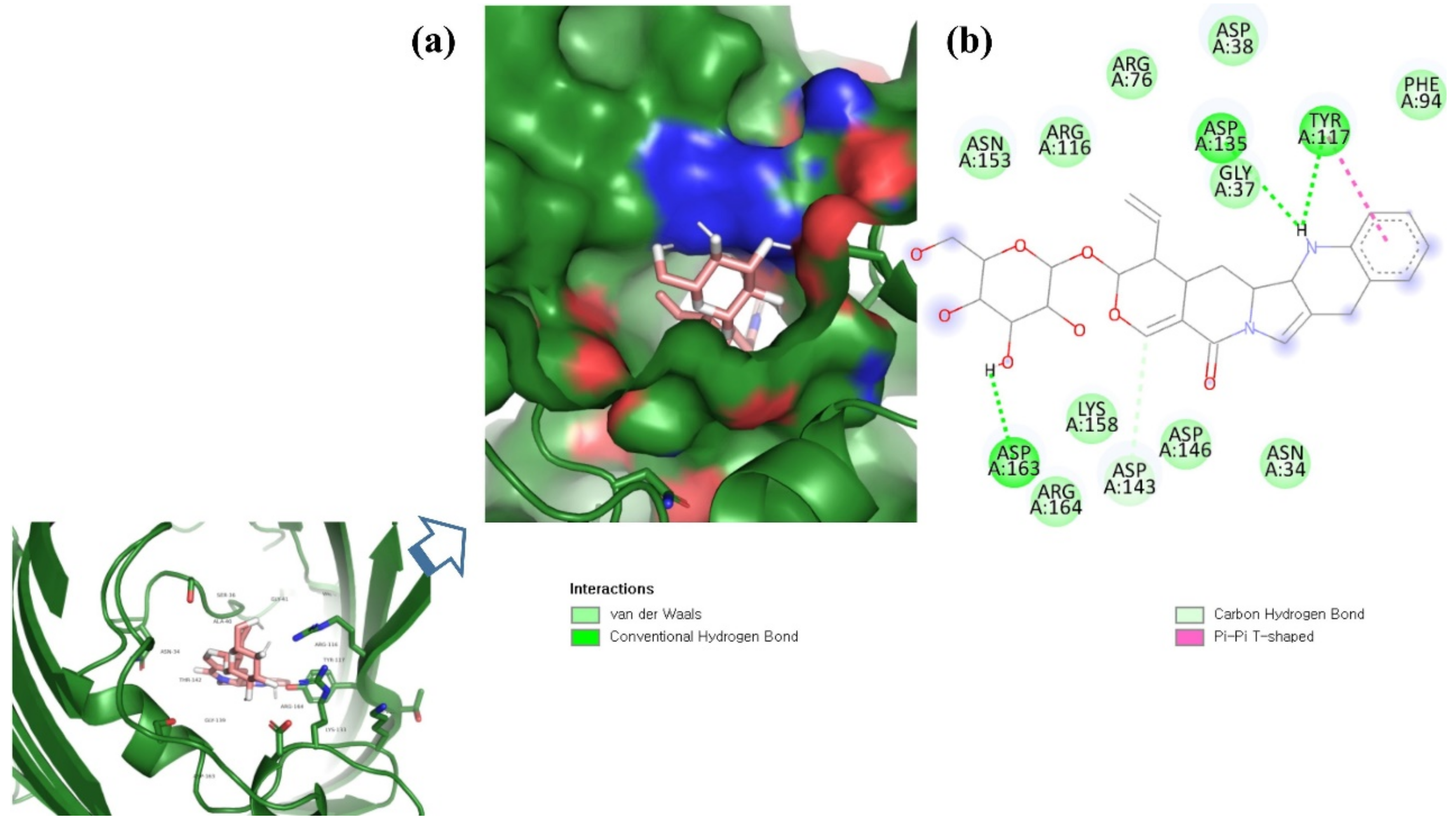

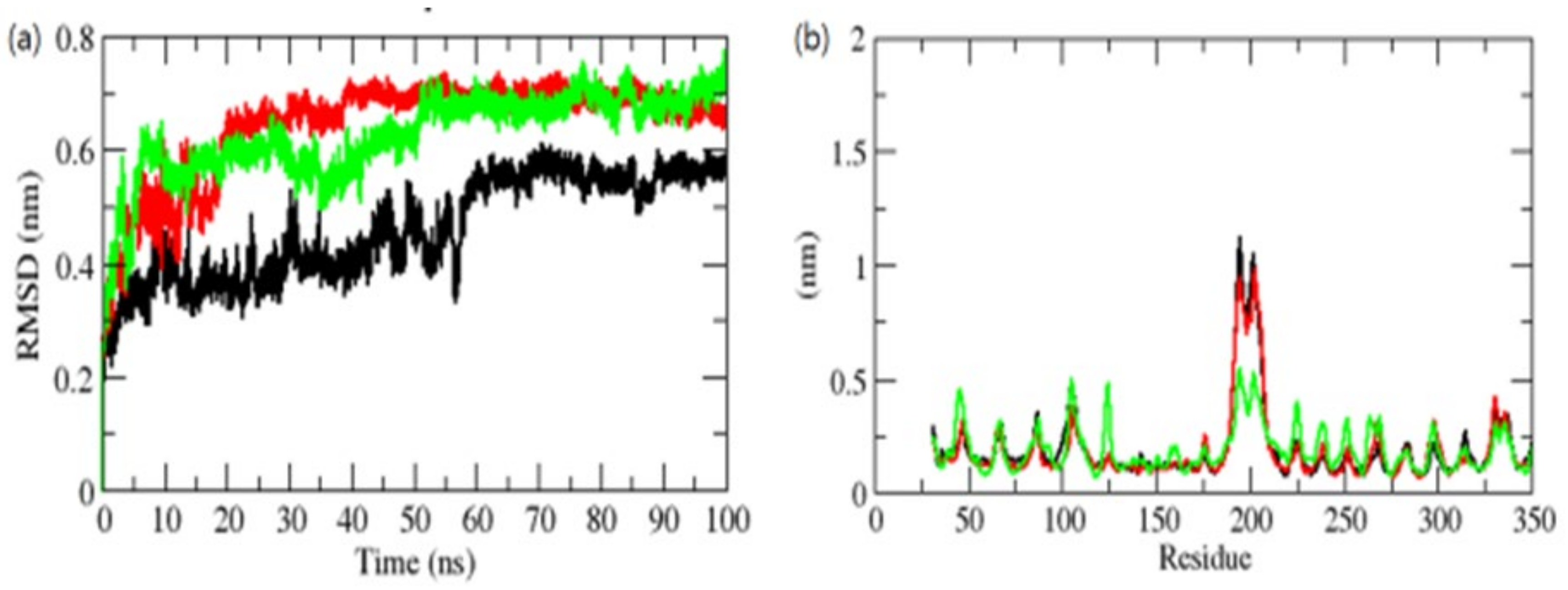


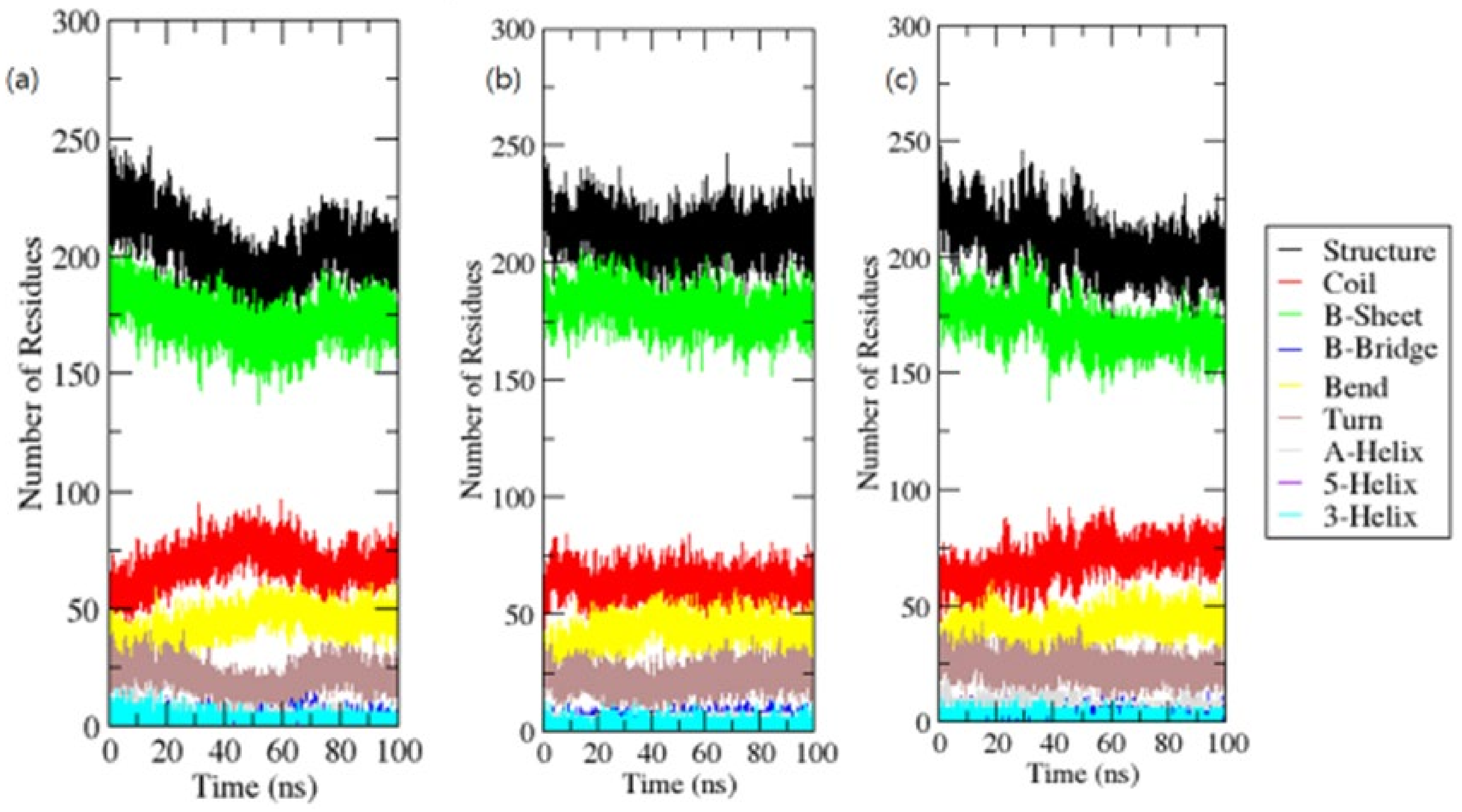
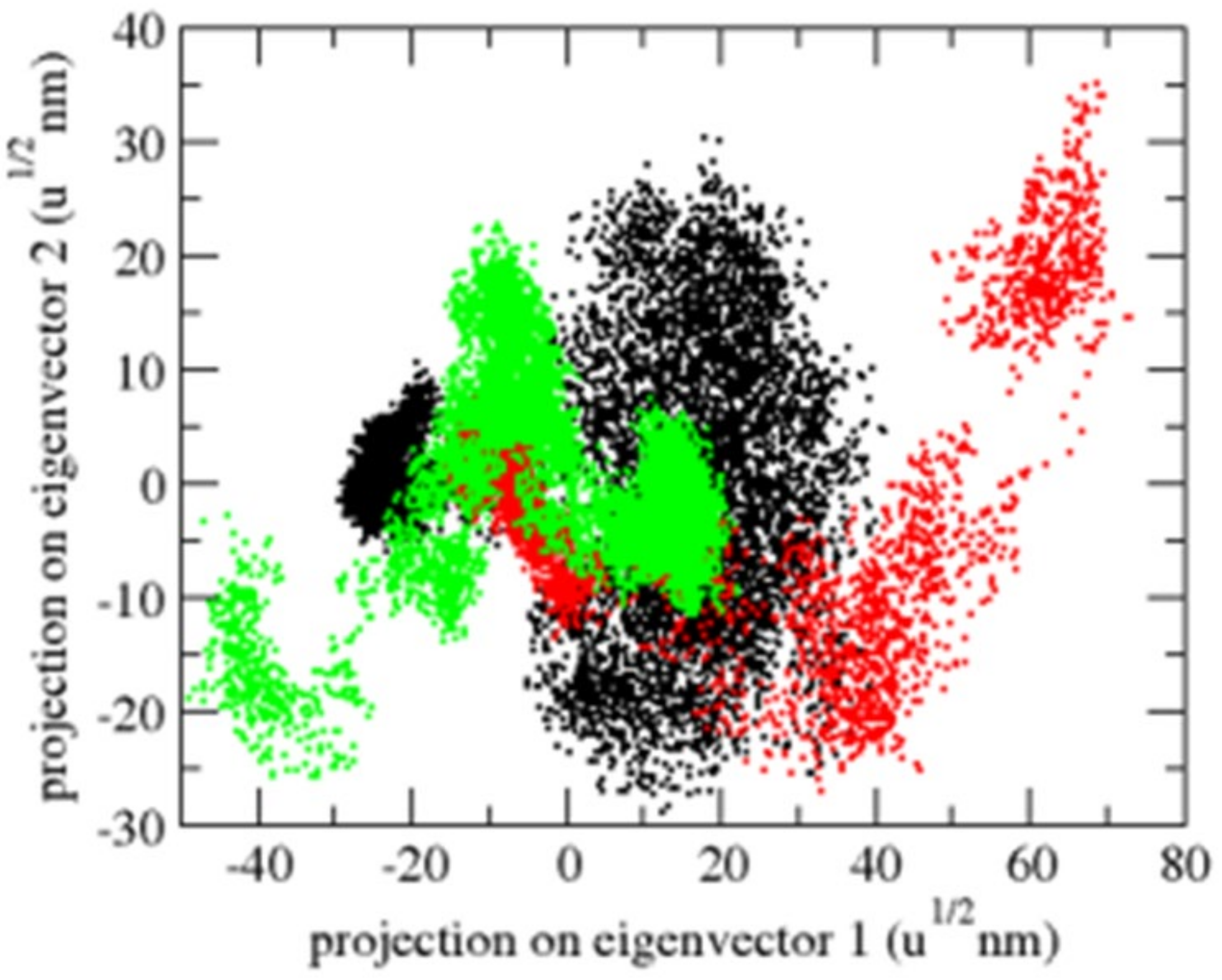

| S. No | Molecule Name | TORSDO | Mol. Weight | cLogP | cLogS | H-Acceptors | H-Donors | Drug Score |
|---|---|---|---|---|---|---|---|---|
| 1 | Control | 6 | 400.437 | 2.1389 | −5.289 | 7 | 2 | 0.610857 |
| 2 | ZINC00119434 | 0 | 335.426 | 1.5935 | −3.554 | 4 | 1 | 0.831709 |
| 3 | ZINC01716562 | 0 | 364.444 | 1.2222 | −3.252 | 5 | 0 | 0.839942 |
| 4 | ZINC06494587 | 2 | 362.384 | 1.8526 | −4.474 | 6 | 0 | 0.726505 |
| 5 | ZINC14588133 | 0 | 424.499 | 3.2063 | −4.481 | 5 | 0 | 0.58483 |
| 6 | ZINC14611877 | 0 | 381.45 | 1.1613 | −3.401 | 6 | 1 | 0.817261 |
| 7 | ZINC15121726 | 0 | 318.375 | 0.9845 | −3.493 | 4 | 1 | 0.845727 |
| 8 | ZINC15211799 | 0 | 313.359 | 3.1159 | −5.781 | 4 | 1 | 0.577681 |
| 9 | ZINC33967683 | 0 | 303.364 | 2.7404 | −3.55 | 4 | 1 | 0.82254 |
| 10 | ZINC34172946 | 0 | 264.283 | 1.9186 | −3.766 | 4 | 2 | 0.812478 |
| 11 | ZINC59587520 | 2 | 352.433 | 0.9499 | −1.303 | 5 | 1 | 0.564557 |
| 12 | ZINC59587626 | 0 | 365.452 | 1.2222 | −3.252 | 5 | 1 | 0.839179 |
| 13 | ZINC70451098 | 3 | 446.458 | 1.0959 | −4.58 | 8 | 2 | 0.273407 |
| 14 | ZINC70454552 | 0 | 350.417 | 0.6201 | −1.385 | 5 | 0 | 0.701361 |
| 15 | ZINC70455615 | 0 | 350.417 | 0.6201 | −1.385 | 5 | 0 | 0.701361 |
| 16 | ZINC85506732 | 4 | 359.401 | −0.7109 | −2.716 | 7 | 1 | 0.416303 |
| 17 | ZINC85508615 | 3 | 345.418 | 0.4553 | −2.903 | 6 | 2 | 0.415682 |
| 18 | ZINC85510056 | 2 | 352.433 | 0.9499 | −1.303 | 5 | 1 | 0.564557 |
| 19 | ZINC85531660 | 3 | 393.505 | 2.4712 | −3.935 | 5 | 1 | 0.743661 |
| 20 | ZINC85532094 | 0 | 289.337 | 2.2665 | −3.576 | 4 | 1 | 0.835381 |
| 21 | ZINC85916780 | 2 | 447.446 | 2.2223 | −4.676 | 9 | 2 | 0.379896 |
| 22 | ZINC95910132 | 8 | 377.732 | −1.1595 | −1.558 | 10 | 5 | 0.227975 |
| 23 | ZINC95910434 | 8 | 498.53 | −0.162 | −3.012 | 10 | 5 | 0.390707 |
| 24 | ZINC95910792 | 0 | 320.391 | 1.2599 | −3.721 | 4 | 1 | 0.828277 |
| 25 | ZINC95912493 | 2 | 350.417 | 0.8454 | −1.039 | 5 | 1 | 0.685761 |
| S.NO. | Molecule Name | Mutagenic | Tumorigenic | Irritant | BBB Permeant | GI Absorption | TPSA | CYP2D6 Inhibitor | Log S | PAINS Alerts |
|---|---|---|---|---|---|---|---|---|---|---|
| 1 | Control | x | x | x | N | H | 85.13 | No | −4.42 | 0 |
| 2 | ZINC00119434 | x | x | x | Y | H | 41.57 | Y | −2.43 | 0 |
| 3 | ZINC01716562 | x | x | x | Y | H | 49.85 | Y | −0.89 | 0 |
| 4 | ZINC06494587 | x | x | x | N | H | 74.76 | N | −3.32 | 0 |
| 5 | ZINC14588133 | x | x | x | Y | H | 53.23 | N | −3.88 | 0 |
| 6 | ZINC14611877 | x | x | x | N | H | 67.87 | Y | −2.35 | 0 |
| 7 | ZINC15121726 | x | x | x | Y | H | 49.41 | Y | −2.46 | 0 |
| 8 | ZINC15211799 | x | x | x | Y | H | 42.2 | Y | −4.48 | 0 |
| 9 | ZINC33967683 | x | x | x | Y | H | 39.34 | Y | −3.59 | 1 |
| 10 | ZINC34172946 | x | x | x | Y | H | 58.2 | Y | −2.22 | 0 |
| 11 | ZINC59587520 | x | x | x | N | H | 69.97 | Y | −1.51 | 0 |
| 12 | ZINC59587626 | x | x | x | Y | H | 58.64 | N | −1.07 | 0 |
| 13 | ZINC70451098 | x | x | H | N | H | 101.09 | Y | −3.23 | 0 |
| 14 | ZINC70454552 | x | x | x | Y | H | 58.97 | Y | −2.3 | 0 |
| 15 | ZINC70455615 | x | x | x | Y | H | 58.97 | Y | −2.3 | 0 |
| 16 | ZINC85506732 | H | L | x | Y | H | 71.61 | Y | −2.3 | 0 |
| 17 | ZINC85508615 | H | L | x | N | H | 85.02 | N | −2.32 | 0 |
| 18 | ZINC85510056 | x | x | x | N | H | 69.97 | N | −1.51 | 0 |
| 19 | ZINC85531660 | x | x | x | Y | H | 50.8 | N | −3.99 | 0 |
| 20 | ZINC85532094 | x | x | x | Y | H | 46.92 | N | −3.21 | 0 |
| 22 | ZINC85916780 | x | x | x | N | H | 112.35 | Y | −3.6 | 0 |
| 23 | ZINC95910132 | x | x | x | N | L | 149.15 | N | −1.7 | 0 |
| 24 | ZINC95910434 | x | x | x | N | L | 140.95 | N | −2.26 | 0 |
| 25 | ZINC95910792 | x | x | x | Y | H | 49.41 | Y | −2.57 | 0 |
| 26 | ZINC95912493 | x | x | x | Y | H | 69.97 | Y | −2.57 | 0 |
| S. No. | Compounds | 2D Structure | Binding Affinity (kcal/mol) | Binding Residues |
|---|---|---|---|---|
| 1 | ZINC06494587 | 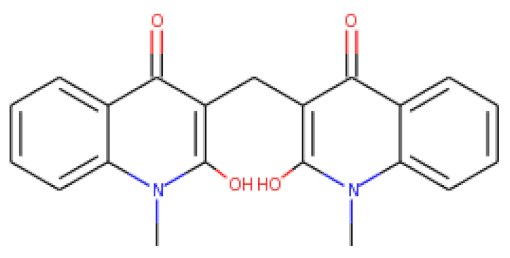 | −8.92 | Glu96, Asp135, Gly37, Tyr117, Tyr119, Phe94, Ala40, Leu80, Gly41, Lys39, Asn78, and Asp38 |
| 2 | ZINC85510056 |  | −8.12 | Arg164, Gly37, Asp38, Gly139, Asp143, Thr142, Lys158, Asp146, Asp163, Asn153, Arg116, and Arg76 |
| 3 | ZINC95910434 |  | −8.78 | Asn153, Arg116, Arg76, Asp38, Asp135, Gly37, Tyr117, Phe94, Asn34, Asp146, Asp143, Lys158, Arg164, and Asp163 |
| 4 | Control compound * | 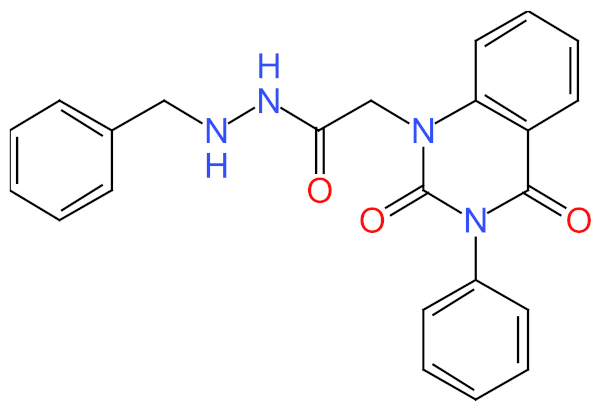 | −7.0 | Arg116, Arg76, Ser36, Gly37, Glu96, Asp38, Tyr119, Phe94, Leu80, Asp143, Asp135, Lys181, Val140, and Gly139 |
Publisher’s Note: MDPI stays neutral with regard to jurisdictional claims in published maps and institutional affiliations. |
© 2021 by the authors. Licensee MDPI, Basel, Switzerland. This article is an open access article distributed under the terms and conditions of the Creative Commons Attribution (CC BY) license (https://creativecommons.org/licenses/by/4.0/).
Share and Cite
Rahaman, A.; Almalki, A.A.; Rafeeq, M.M.; Akhtar, O.; Anjum, F.; Mashraqi, M.M.; Sain, Z.M.; Alzamami, A.; Ahmad, V.; Zeng, X.-A.; et al. Identification of Potent Natural Resource Small Molecule Inhibitor to Control Vibrio cholera by Targeting Its Outer Membrane Protein U: An In Silico Approach. Molecules 2021, 26, 6517. https://doi.org/10.3390/molecules26216517
Rahaman A, Almalki AA, Rafeeq MM, Akhtar O, Anjum F, Mashraqi MM, Sain ZM, Alzamami A, Ahmad V, Zeng X-A, et al. Identification of Potent Natural Resource Small Molecule Inhibitor to Control Vibrio cholera by Targeting Its Outer Membrane Protein U: An In Silico Approach. Molecules. 2021; 26(21):6517. https://doi.org/10.3390/molecules26216517
Chicago/Turabian StyleRahaman, Abdul, Abdulraheem Ali Almalki, Misbahuddin M. Rafeeq, Omar Akhtar, Farah Anjum, Mutaib M. Mashraqi, Ziaullah M. Sain, Ahmad Alzamami, Varish Ahmad, Xin-An Zeng, and et al. 2021. "Identification of Potent Natural Resource Small Molecule Inhibitor to Control Vibrio cholera by Targeting Its Outer Membrane Protein U: An In Silico Approach" Molecules 26, no. 21: 6517. https://doi.org/10.3390/molecules26216517







